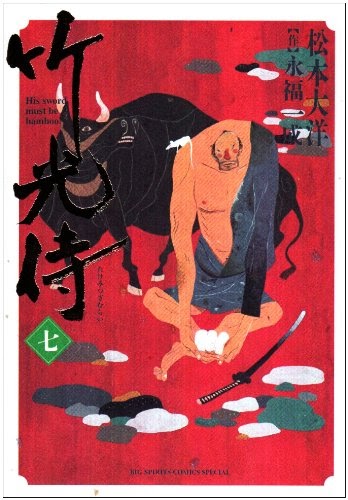
Idioma original: Japanese
Original title: Bamboo sword samurai
Translation: Marc Bernabé
Year of publication: 2006
Valuation: highly recommended
I discovered this comic at an exhibition on the representation of Tokyo settings in audiovisual media. Generally, due to commercial regulations, privacy issues or pure convenience, the settings that appear in comics tend to be generic. However, in some cases, writers and cartoonists take on the task of faithfully depicting the landscapes where the action takes place. One of the notable cases is Kimi no na wa (Your Name), where the appearance of real settings motivated a pilgrimage to the locations of the anime. Similarly, Issei Eifuku shows us the landscapes and lifestyle of the capital of feudal Japan, in the style of “slice of life” comics or period novels (時代小説), very popular in Japan.

In this setting, we are presented with the story of the ronin Senō Sōichiro, who has just arrived in the capital. Unlike other samurai stories, Sōichiro’s personality diverges from the stoic philosophy of bushido. In contrast to other comic book samurai such as Musashi from Vagabond or Battōsai from Rurouni Kenshin, he seeks a more routine life in his new home, as evidenced by his abandonment of his katana, which has shed much blood, in favor of a bamboo staff, something unworthy of a samurai.
The plot at the beginning reminded me of the film A History of Violence, starring Viggo Mortensen, where the protagonist buries his violent past to create a new, peaceful and ordinary life. Likewise, Sōichiro’s past is a mystery that is revealed throughout the volumes, represented at times by the appearance of a one-eyed woman, the spirit of his old murderous katana. The story develops at a slow but captivating pace, allowing the characters and their relationships to evolve organically. There are also many reflective dialogues, offering insight into the characters’ motivations and internal conflicts. The combination of calm moments with intense action scenes creates a balance that keeps you hooked.
.jpg)
Another strong point (for some, the strongest) is the drawing. Nothing to do with what comes to mind when we hear the word “manga”. The strong strokes, sometimes a little careless, transmit dynamism in the action scenes; the fine strokes, delicacy and serenity. The distorted postures and features fit the personality of the characters. The exaggeration of the distortion of proportion and perspective even comes close to resembling cubism (a nod to Guernica tells us that this was done with full intention). The shadows make the most of the monochrome characteristic of Japanese comics, while the watercolor of the color vignettes evokes the style of ukiyo-e.
In conclusion, Takemitsu Zamurai is a work that combines an intriguing narrative with a unique artistic style, offering a fresh and deep look at stories in feudal Japan. It is a must-read for those looking for something more than a conventional samurai story and wish to immerse themselves in a visually and emotionally enriching experience.
.jpg)
.jpg)

Source: https://unlibroaldia.blogspot.com/2024/09/issei-eifuku-y-taiyo-matsumoto.html


